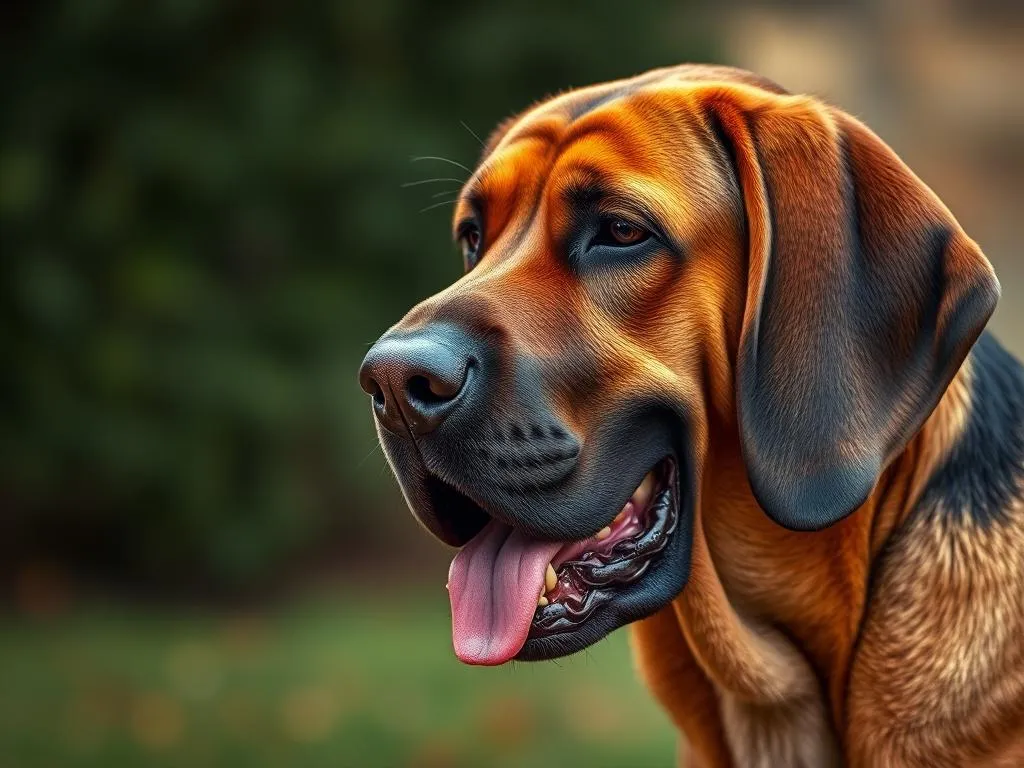
The Bloodhound is a remarkable breed known for its keen sense of smell and relentless tracking ability. With their droopy ears and distinctive facial wrinkles, these dogs have become iconic not only for their skills but also for their unique bloodhound colors. The coat color of a Bloodhound plays a significant role in breed identification and can often influence the perception of the breed itself. In this article, we will delve into the various colors of Bloodhounds, exploring their significance and the genetics behind them.
Understanding Bloodhound Colors
Coat color in dogs is more than just a visual trait; it serves as an identifier for breed standards and lineage. For Bloodhounds, coat color can be crucial for breed identification and can even play a role in the dog’s temperament and health. The genetic factors influencing bloodhound colors are complex, involving multiple genes that contribute to the coloration and patterns observed within the breed.
Genetic Factors Influencing Coat Color
The colors found in Bloodhounds are primarily dictated by genetics. For example, the black and tan coloration results from specific combinations of dominant and recessive genes. Understanding these genetic factors can help prospective owners appreciate the diversity of colors within the breed.
Common Bloodhound Colors
Bloodhounds are most commonly seen in a few distinct colors. Each color has its unique characteristics and historical significance.
Black and Tan
One of the most recognizable colors in Bloodhounds is black and tan. This coloration features a rich black base with distinct tan markings on the muzzle, legs, and eyebrows. The black and tan pattern is not only visually striking but also historically significant, as it has been favored in hunting breeds for its functionality in outdoor environments. According to breed standards, this color is highly sought after and is often the most recognized among Bloodhounds.
Liver and Tan
Another prevalent color is liver and tan, which has a warm, reddish-brown base rather than the black of the previous color. The liver color is a result of a different genetic combination and is equally stunning. Compared to black and tan, the liver and tan coloration is less common but cherished for its unique appeal. Many owners appreciate the softer, more natural look of a liver and tan Bloodhound.
Red
The red Bloodhound is characterized by a solid, deep red coat. This coloration is less common than the black and tan or liver and tan, but it has gained popularity due to its striking appearance. Solid red Bloodhounds are often perceived as more vibrant and energetic. Over the years, they have become increasingly popular, particularly among those who appreciate the distinct aesthetics of a solidly colored dog.
Other Possible Colors
While the aforementioned colors are the most common, there are some rare variations, such as blue or brindle. These colors are not recognized by all breed standards and are often considered atypical. The genetic basis for these rare colors can be traced back to recessive genes that appear infrequently in the breed. Although these colors can be visually appealing, they often come with mixed opinions regarding their adherence to breed standards.
Coat Patterns and Markings
Apart from colors, Bloodhounds can also exhibit various coat patterns and markings that contribute to their overall appearance.
Understanding Patterns
Bloodhounds can have solid, brindle, or spotted patterns. A solid coat is uniform in color, while a brindle pattern features a mix of darker and lighter stripes. Spotted patterns can include various spots scattered across the coat. Each of these patterns presents a different visual aesthetic, contributing to the breed’s unique charm.
Importance of Markings
Markings can significantly influence a Bloodhound’s appearance and are often seen as a reflection of the dog’s lineage. For example, a Bloodhound with distinct facial markings may stand out more in competitions or shows. Common markings include a lighter patch on the chest or unique facial markings that emphasize the breed’s expressive eyes and droopy ears.
Factors Influencing Bloodhound Coat Color
Several factors can influence the coloration of a Bloodhound’s coat, ranging from genetics to environmental aspects.
Genetics
The genetics of coat color inheritance is complex. Bloodhounds inherit their coat color from their parents, with dominant and recessive genes playing a significant role. A solid red Bloodhound, for instance, may carry genes that could produce different colors if bred with another Bloodhound of a different color. Understanding these genetics can be essential for breeders aiming to produce specific colors.
Environmental Influences
Environmental factors can also impact the appearance of a Bloodhound’s coat. Diet plays a crucial role; a well-balanced diet rich in vitamins and minerals can enhance coat health and appearance. Moreover, seasonal changes can affect coat color, as some dogs experience slight color variations with changes in temperature or sunlight exposure. This phenomenon is particularly noticeable in breeds with double coats.
Bloodhound Colors in Popular Culture
The unique bloodhound colors have made these dogs a favorite in various media representations.
Representation in Media
Bloodhounds have been featured in numerous movies, television shows, and literature, often depicted as loyal companions or skilled trackers. Their distinctive colors and appearance make them memorable characters, contributing to their popularity. Films like “The Hound of the Baskervilles” highlight the breed’s tracking abilities while showcasing their unique colors.
Public Perception
Public perception of Bloodhounds can be influenced by their colors. For example, the classic black and tan is often viewed as the quintessential Bloodhound, which may increase its adoption rates compared to more unusual colors. This perception can affect how potential owners view the breed, leading to preferences for specific colors over others.
Caring for Bloodhound Coat by Color
Caring for a Bloodhound’s coat varies based on its color and type. Understanding these needs can help owners maintain their dog’s appearance and health.
Grooming Tips
Grooming is essential for all Bloodhounds, but the specific needs can differ based on coat color. For instance, black and tan and liver and tan Bloodhounds may require regular brushing to manage shedding and maintain a healthy coat. Solid red Bloodhounds might need special attention to ensure their coat remains vibrant and free of mats. Regular baths with appropriate shampoos can help keep their coats clean and shiny.
Health Considerations
Certain health issues can be associated with specific bloodhound colors. For example, lighter-colored coats may be more prone to sunburn, necessitating additional care during sunny months. Regular veterinary check-ups are crucial for all Bloodhounds, regardless of coat color, as they can help identify and address any health concerns early on.
Conclusion
The significance of bloodhound colors extends beyond aesthetics; it encompasses breed identification, genetics, and even public perception. When choosing a Bloodhound, potential owners should consider how coat color may impact their experience with the breed. Ultimately, every Bloodhound, regardless of its color, deserves responsible ownership and appreciation for its unique qualities. Whether you are drawn to the classic black and tan, the warm liver and tan, or the striking red, understanding these colors can enhance your relationship with this extraordinary breed.
FAQs
What are the most common Bloodhound colors?
The most common Bloodhound colors include black and tan, liver and tan, and solid red.
Are there rare Bloodhound colors?
Yes, rare colors such as blue or brindle can occur, although they are not widely recognized by all breed standards.
Does coat color affect a Bloodhound’s temperament?
No, coat color does not influence a Bloodhound’s temperament. Temperament is more closely related to genetics and individual personality rather than color.
How often should I groom my Bloodhound based on its coat color?
Grooming frequency may vary, but generally, Bloodhounds should be brushed weekly to manage shedding and maintain coat quality. More frequent grooming may be necessary for those with longer or thicker coats.
Are certain colors more prone to health issues?
While some health issues may be more common in specific colors, all Bloodhounds should receive regular veterinary care to monitor their overall health and well-being.









